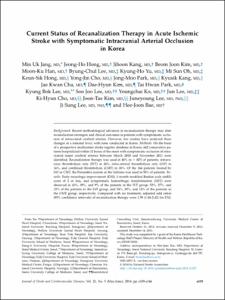KUMEL Repository
1. Journal Papers (연구논문)
1. School of Medicine (의과대학)
Dept. of Obstetrics & Gynecology (산부인과학)
Current status of assisted reproductive technology in Korea, 2009
- Affiliated Author(s)
- 이정호
- Alternative Author(s)
- Rhee, Jeong Ho
- Journal Title
- Obstetrics & Gynecology Science
- ISSN
- 2287-8572
- Issued Date
- 2013
- Abstract
- Great advances have been made in the field of assisted reproductive technology (ART) since the first in vitro fertilization (IVF) baby was born in Korea in the year of 1985. However, it deserve to say that the invaluable data from fertility centers may serve as a useful source to find out which factors affect successful IVF outcome and to offer applicable information to infertile patients and fertility clinics. This article intended to report the status of ART in 2009 Korean Society of Obstetrics and Gynecology surveyed. The current survey was performed to assess the status and success rate of ART performed in Korea, between January 1 and December 31, 2009. Reporting forms had been sent out to IVF centers via e-mail, and collected by e-mail as well in 2012. With International Committee Monitoring Assisted Reproductive Technologies recommendation, intracytoplasmic sperm injection (ICSI) and non-ICSI cases have been categorized and also IVF-ET cases involving frozen embryo replacement have been surveyed separately. Seventy-four centers have reported the treatment cycles initiated in the year of 2009, and had performed a total of 27,947 cycles of ART treatments. Among a total of 27,947 treatment cycles, IVF and ICSI cases added up to 22,049 (78.9%), with 45.3% IVF without ICSI and 54.7% IVF with ICSI, respectively. Among the IVF and ICSI patients, patients confirmed to have achieved clinical pregnancy was 28.8% per cycle with oocyte retrieval, and 30.9% per cycle with embryo transfer. The most common number of embryos transferred in 2009 is three embryos (40.4%), followed by 2 embryos (28.4%) and a single embryo transferred (13.6%). Among IVF and ICSI cycles that resulted in multiple live births, twin pregnancy rate was 45.3% and triple pregnancy rate was 1.1%. A total of 191 cases of oocyte donation had been performed to result in 25.0% of live birth rate. Meanwhile, a total of 5,619 cases of frozen embryo replacement had been performed with 33.7% of clinical pregnancy rate per cycle with embryo transfer. When comparing with international registry data, clinical pregnancy rate per transfer from fresh IVF cycles including ICSI (34.1%,) was comparable to clinical pregnancy rate per transfer in European Society for Human Reproduction and Embryology report was 32.5% though lower than 45.0% for USA data. There was no remarkable difference in status of assisted reproductive technology in Korea between the current report and the data reported in 2008. The age of women trying to get pregnant was reconfirmed to be the most important factor that may have impact on success of ART treatment.
Keywords: International Committee for Monitoring Assisted Reproductive Technologies; Korea; Reproductive techniques; Survey
- Department
- Dept. of Obstetrics & Gynecology (산부인과학)
- Publisher
- School of Medicine
- Citation
- Tae Ki Yoon et al. (2013). Current status of assisted reproductive technology in Korea, 2009. Obstetrics & Gynecology Science, 56(06), 353–361. doi: 10.5468/ogs.2013.56.6.353
- Type
- Article
- ISSN
- 2287-8572
- Appears in Collections:
- 1. School of Medicine (의과대학) > Dept. of Obstetrics & Gynecology (산부인과학)
- 파일 목록
-
-
Download
 oak-aaa-04032.pdf
기타 데이터 / 92.75 kB / Adobe PDF
oak-aaa-04032.pdf
기타 데이터 / 92.75 kB / Adobe PDF
-
Items in Repository are protected by copyright, with all rights reserved, unless otherwise indicated.